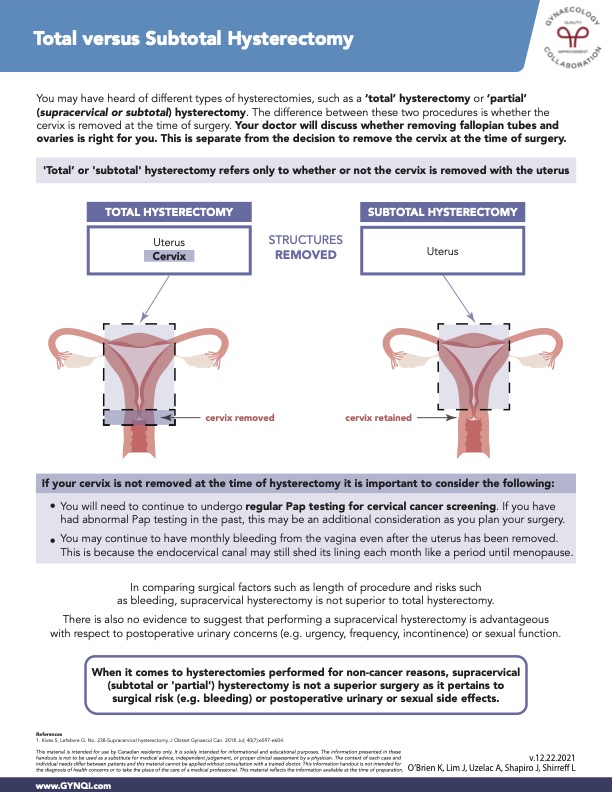
Table of Contents
- Summary
- Understanding Hysterectomy Options: Total vs. Subtotal
- Subtotal Hysterectomy Follow-Up
- Surgical Factors and Outcomes
- Finding the Right Solution for You
Summary:
- There are two main types of hysterectomies: “total,” which involves the removal of the uterus and cervix, and “subtotal” (or supracervical), where the uterus is removed but the cervix is retained.
- If the cervix is not removed, patients must continue regular Pap tests for cervical cancer screening and may still experience monthly bleeding until menopause.
- Research shows that a “subtotal” hysterectomy does not provide any advantages over a “total” hysterectomy concerning surgical risks, such as bleeding, or potential postoperative urinary or sexual health issues.
- Understanding the implications of each procedure, including the option of removing the fallopian tubes and ovaries, is essential for making an informed choice about your surgical care.
Choosing the right type of hysterectomy is an important decision, as it involves understanding the differences between a “total” and “subtotal” (or supracervical) procedure. The primary distinction centers around whether the cervix is removed, which can impact post-surgery care and potential health outcomes. Additionally, your doctor may discuss the option of removing the fallopian tubes and ovaries, which is a separate decision from cervix removal.
Knowing what each type of hysterectomy involves can help you make a more informed choice that aligns with your specific health needs.
Understanding Hysterectomy Options: Total vs. Subtotal
You may be familiar with different types of hysterectomies, including “total” and “subtotal” (supracervical or partial) hysterectomies. The primary distinction between these procedures lies in whether the cervix is removed during surgery. Your doctor will also discuss the potential removal of the fallopian tubes and ovaries, which is a separate consideration from the decision to remove the cervix.
In essence, “total” and “subtotal” hysterectomies refer specifically to whether the cervix is removed along with the uterus.
Subtotal Hysterectomy Follow-Up
If your cervix is not removed at the time of hysterectomy it is important to consider the following:
- You’ll need to continue regular Pap tests for cervical cancer screening. If you’ve had abnormal Pap results in the past, this should be an additional factor to discuss when planning your surgery.
- You may still experience monthly bleeding even after the uterus is removed. This occurs because the endocervical canal can continue to shed its lining each month, similar to a period, until menopause.
Surgical Factors and Outcomes
When comparing surgical factors like procedure length and bleeding risks, a “subtotal” (supracervical) hysterectomy offers no advantage over a “total” hysterectomy. There is also no evidence that a “subtotal” hysterectomy benefits postoperative urinary issues (such as urgency, frequency, or incontinence) or sexual function.
For non-cancer-related hysterectomies, a “subtotal” (supracervical or partial) hysterectomy does not offer any benefits over a full hysterectomy in terms of surgical risks, like bleeding, or potential side effects related to urinary or sexual health.
Finding the Right Solution for You
In summary, the key difference between “total” and “subtotal” hysterectomies is whether the cervix is removed. For non-cancer-related cases, subtotal hysterectomies offer no advantages over total hysterectomies regarding surgical risks or postoperative outcomes. If the cervix is retained, ongoing Pap tests and possible monthly bleeding until menopause should be considered.
Discussing these factors with your doctor will help you make the best choice for your health.



